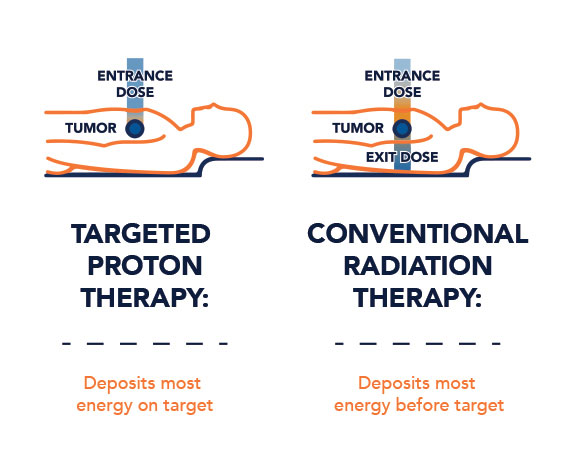Targeted precision
How is Proton Therapy Different from Other Advanced Cancer Therapies?
Proton therapy is an advanced form of radiation therapy for cancer treatment that uses precise high-energy beams to destroy cancer cells. Compared to traditional X-ray radiation, it helps you beat cancer with fewer side effects for a better quality of life.
In traditional radiation therapy, photons, also called X-rays, travel through the body, delivering cancer-killing energy as they go. As a result, X-ray radiation has both an entrance and exit dose, damaging healthy tissues surrounding your tumor. Read more about the differences between proton radiation and radiation therapy.
Proton therapy uses protons, which are charged particles, to precisely target tumors within the body. Because charged particles have mass, the distance they travel in the body can be predicted. Protons release energy differently than photons by releasing a burst of energy at the end of their path. Protons can travel a precise distance in the body and stop, thus reducing radiation doses to meaningful non-cancerous tissues.

Who is a Good Candidate for Proton Therapy?
The precision of proton therapy makes it an effective, non-invasive cancer treatment option for many types of cancer, including those found in hard-to-reach and sensitive areas of the body, like the neck or brain. In many cases, children also benefit from the precision of proton beam therapy, which offers targeted cancer treatment with less damage to developing structures and less risk of secondary cancer.
Cancer types we treat include:

Available Proton Cancer Treatments
At the UF Health Proton Therapy Institute, we have the latest advances in proton therapy for cancer, including pencil beam scanning and double scattering. In 2023, we completed a $44 million expansion and upgrade project that allows us to treat patients in five state-of-the-art treatment rooms, each equipped with the latest image guidance for pinpoint precision.
Learn more about the non-invasive cancer treatments available to you.
What to Expect During Proton Therapy
When you choose proton cancer treatment with the UF Health Proton Therapy Institute, you will be matched with a team of cancer experts who will see you through every step of the process. While you’re here, you will receive daily non-invasive cancer treatments that last approximately 15-45 minutes and deliver powerful, precise and painless doses of radiation directly to your tumor site.
Watch the video below to learn more about the proton therapy process and receiving advanced cancer therapy in Jacksonville.
Learn more about the benefits of proton therapy.
Proton therapy is effective in treating more than 20 types of cancer.

